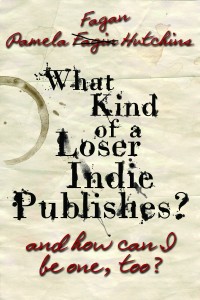An adapted and unedited chapter from my upcoming SkipJack Publishing book (release date August 15, 2013) What kind of loser indie publishes, and how can I be one too?
Good strategy makes you a soothsayer. It can capture profit when margins are slim. It’s sleek, it’s stylish, it’s sexy. So let’s get sexy together.
When it comes to indie publishing, your three main, sexy strategy choices are around 1) what format to publish your book in, 2) where to publish it, and 3) how to price it. Think of this as what you’ll be wearing, where you’ll be shaking it, and whether you’re the kind of date that needs dinner and a movie first.
To kick off our strategy discussion, I need to address options for International Standards Book Numbers (ISBNs), which are unique, country-specific numeric commercial book identifiers of 10 or 13 digits. OK, they’re not so sexy. Buzz kill.
Let me give you a taste of ISBNs. An ISBN gets assigned to each edition and variation/format of a book, except for reprintings. For example, an ebook, a paperback, an audiobook, and a hardcover of a book will each have a different ISBN, with one exception. Amazon Kindle and Barnes and Noble Nook do not require ebook ISBNs. Because ISBNs are not free, this can be significant. Thus, if you plan to publish only ebooks and only on these two sites, you don’t need to spend a cent on ISBNs.
In the good old US of A, you can purchase ISBNs singly or in discounted volumes through Bowker (http://myidentifiers.com). You can also get ISBNs from some author-assisted service providers, if you list the service provider as your publisher. As you can see below, buying single ISBNs is quite pricey. Bowker’s unit price falls dramatically with modest volume.
You’ll need more information on ISBNs, but I’ll save it for a later post.
One more libido-dampening topic to address before we bring sexy back: digital rights management (DRM). Most web channels allow you to choose whether to enable digital rights management on your ebook. DRM is a method of controlling access to copyrighted material for a variety of content in digital formats.
Those that favor DRM are trying to prevent theft of digital content. However, most of the major web channels (Kindle, Nook, Apple, Kobo) highly disfavor the use of DRM, as do end users. Critics complain that DRM is overly restrictive and prohibits legal use. Techies suggest that DRM doesn’t do much to reduce illegal usage, as the type of users who would want to steal it still can. Without going down that rabbit hole, let me just tell you this: one of the fastest ways to get flamed on message boards is to enable DRM.
Whoa, is it just me or is this DRM stuff a little sexy after all?
Heck, people pass print books around and paw them until the pages wear out, and we’re still buying books. How about instead of worrying whether people will steal your content, worry about whether they’ll ever sit down and read all the way through your book at all? That’s a much more realistic problem for you to face. Then rejoice if someone reads it, lends it, and creates another fan for your next book. If you follow my reasoning, there’s no need for DRM on indie books. So, at this time anyway, I highly recommend you do not enable DRM on your ebooks.
In my next post/excerpt-from-Loser, I’ll bring the candles and champagne, and we’ll talk about ebook strategy.
And, no, I’m not just being a tease.
Pamela
 Pamela Fagan Hutchins is an employment attorney and workplace investigator by day who writes award-winning and bestselling mysterious women’s fiction (Saving Grace) and humorous nonfiction (How to Screw Up Your Kids) by night. She is passionate about great writing and smart author-preneurship. She also leaps medium-tall buildings in a single bound, if she gets a good running start.
Pamela Fagan Hutchins is an employment attorney and workplace investigator by day who writes award-winning and bestselling mysterious women’s fiction (Saving Grace) and humorous nonfiction (How to Screw Up Your Kids) by night. She is passionate about great writing and smart author-preneurship. She also leaps medium-tall buildings in a single bound, if she gets a good running start.

